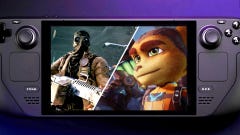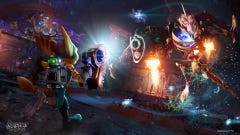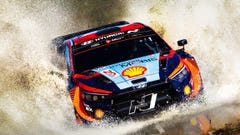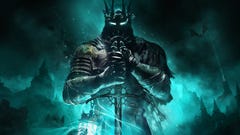Can Ratchet and Clank: Rift Apart on PC match - and exceed - the PS5 experience?
And how do lower spec PCs fare?
We've mentioned before that Ratchet and Clank: Rift Apart is a crucial port for the PC platform, primarily because the game is built from the ground up around the concept of exploiting a games machine with access to a state of the art storage solution, the low-level APIs to get the most out of it, along with dedicated silicon to decompress assets on the fly without needing to bother the CPU. Now the game is here and while developer Nixxes has done the heavy lifting and basically solved the storage challenge, a number of issues remain that we hope to see cleaned up via patches in the coming days and weeks.
We received code for this relatively late, so our deep dive review coverage is still work-in-progress, but we have put together a detailed 'let's play' video that shows three members of the Digital Foundry team playing the game on three very different pieces of hardware. I played on a max spec PC, featuring a Core i9 12900K paired with an RTX 4090 and 32GB of fast DDR5, while Rich Leadbetter enjoyed the min spec experience: a Ryzen 3 3100 working in concert with 8GB of DDR4, while an RX 570 4GB is essentially the min spec RX 470 4GB with a circa 100MHz overclock. Meanwhile, John Linneman defined the baseline experience, running on PlayStation 5 in performance RT mode - our preferred way to play.
I'm not going to spoil too much of the video, but one of the prime takeaways is that some stutter issues apart (which may be down to the Radeon driver, but looks more like a CPU bottleneck), the minimum spec system works fairly well. Despite running at 720p on 'very low' settings, the game is still recognisably Ratchet and Clank: Rift Apart, just with a significant detail haircut and very, very low resolution textures. Performance varies between 30fps and 60fps, but again, it does seem like running the RX 570 at 720p causes CPU bottlenecks. The issue we found with this card is that the 4GB of framebuffer memory proved unstable in the build we first had - and crashes were possible simply by moving from the very low to low preset.
All of which leads us onto one of the more inane discussion points we've seen: the fact that the game runs on slower machines with no SSD when Insomniac claimed that the SSD was essential for the game they'd created. First of all, the difference between the console experience and the 'very low' setting is frankly immense in terms of data transfer. Secondly, the comment was likely made in relation to the other development platform available to them, the PlayStation 4. In the video you'll witness the carnage of what happens when you try to run Ratchet and Clank: Rift Apart on a launch PS4 512GB HDD - even the very low setting doesn't work and the game eventually crashes. The point is that to make the game work across as many PCs as possible, Nixxes did what Insomniac did not need to: necessarily, they scaled the game by introducing quality presets and in common with Marvel's Spider-Man Remastered, that includes increasing fidelity for higher-end systems and reducing it where needed.
Nixxes uses the GPU-accelerated DirectStorage 1.2 as its API of choice for handling the task of replicating PlayStation 5's storage strengths, but there has been some confusion about how it is deployed in the wake of reported comments describing how it's only used on higher graphical settings, the implication being that lower settings use the CPU instead. Having talked to Nixxes about it, the reality is that both CPU and GPU decompression are used on different classes of assets.
So, larger assets such as textures are in the GDeflate format and they all decompressed using the GPU, without exception. Smaller assets, like some models and very small textures (at the end of the mip chain) are compressed with LZ4 and decompress on the CPU instead. The end result is a scalable system that works across a range of PC set-ups and can even operate on a hard drive too - albeit with notable pauses on the portal jumps.
However, it's painful to say that while most of Nixxes' objectives are achieved - the storage challenge in particular -, there are a host of smaller issues that need addressing. Across our testing across multiple systems, there are clear stability issues. Not only that, but while it's possible to scale the game beyond PlayStation 5, there are a number of oddities, omissions and weirdness that just isn't right. For example, on a mainstream Ryzen 5 3600 system with an RTX 2070 Super (or go-to system for console comparisons), the main menu runs at sub-60fps. Storage-heavy transfers can cause performance problems that see CPU and GPU under-utilised - even when using a 3.5GB/s NVMe drive.
Maxed out, there are a number of inexplicable graphical regressions you'll see in the video. There are missing transparency effects present on PS5, but absent on the maxed PC experience. We also noted incorrect opacity levels, non-working texture filtering on some surfaces and even texture loading issues, where the PS5-grade asset simply never loaded on the PC game. There are ray tracing consistency problems where the maxed experience can have some areas that are of a lower quality than PS5, while driver issues have seen Nixxes completely remove RT support for AMD owners - for now. I've even had issues with my gamepad where X and Y axes invert on their own for no reason. I'd also expect to see some improvement in streaming performance: right now, the portal transition process does indeed complete more quickly on PlayStation 5 than it does on the most high-end PC around.
All of these issues give the impression that - once again - a PC port has launched when it's not in a fully polished state. We are already over two years on from the debut of the original PlayStation 5 game, so waiting another month or two for an actually finished and polished PC version should not be a big deal. Whether it's with Ratchet and Clank, Sackboy: A Big Adventure or The Last of Us Part 1, Sony keeps shipping games with obvious problems at launch.
| WIP Settings Comparison | PS5 Performance RT | Optimised Settings |
|---|---|---|
| Hair Quality | Medium/High | Medium |
| Weather Particle Quality | Medium/High | Medium |
| Level of Detail | Between Medium and High | Medium |
| Traffic Density | High | High |
| Shadows | High | Medium |
| RT Reflections | High | High |
| RT Object Range | 9 (but worse at a distance) | 6-7 |
That takes the sheen off some obvious triumphs. Although Insomniac's ITGI temporal injection upscaler is present as an option, DLSS and XeSS offer superior upscaling options, while DLSS 3 frame generation is also present for an easy frame-rate boost. FSR 2.1 is also implemented, but can have some image quality issues - even when compared against ITGI. Put simply though, image quality can outstrip the PlayStation 5's performance RT mode. RT shadows and RT ambient occlusion are also present where they are not on PlayStation 5.
We're still working on the coverage, but the table above gives you some idea of the key quality settings and where PlayStation 5's performance RT mode sits in relation to the new PC port. Where a setting is marked as medium/high, I could spot no real difference between the two in my test-case scenarios, while the LOD setting seems to sit at some point between medium and high on the PC scale. While our optimised settings put the RT reflections at an equivalent to PS5's high, I should point out that DLSS reconstruction is not quite as detailed as the checkerboarding on reflections that PS5 uses.
So, that's where we are with Ratchet and Clank: A Rift Apart based on the time we've had with it. It's impressive overall, highly scalable (Steam Deck verification on this one actually seems justified!) and a knockout from a visual perspective - but I can't help but feel some level of disappointment that overall polish isn't quite where it should be.

















